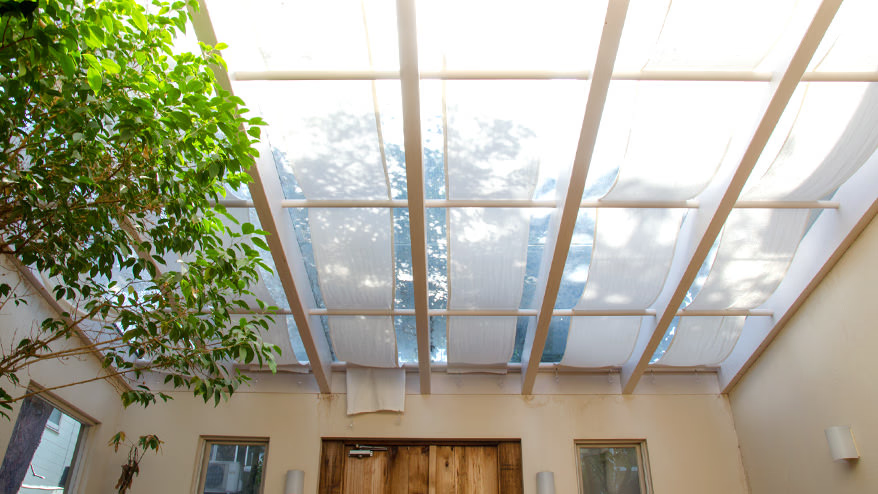Many Monosus staff spend most of their day at the office, but that doesn't just mean sitting at a desk. They also spend a lot of time eating lunch, chatting in the courtyard, playing darts over coffee, relaxing on the sofa, and spending time just like they live there. It's important for an office to be as comfortable as your own home.
The comfort of an office is also connected to the "comfort of working." I think that "comfort of working" can be improved by paying attention to the comfort of shared spaces as well as individual spaces.
This time, we would like to introduce some efforts to improve "comfort at work," focusing on the "Dream Curtain Project," which could be said to be the origin of Monosu-style DIY.
The dream skylight was hot.
Dream Curtain Project launched
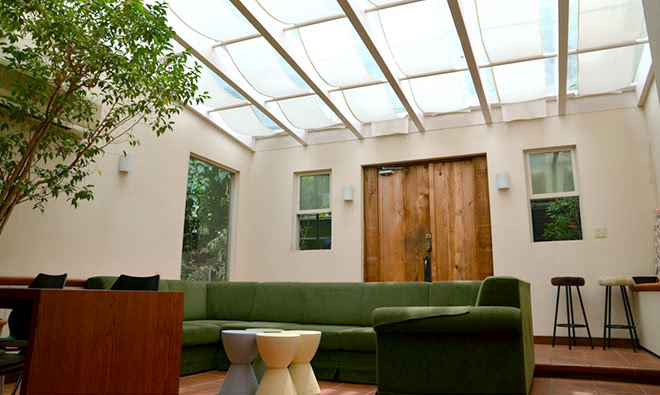
When we first viewed the property, our CEO, Hayashi, was amazed by the skylight and plants in the entrance, exclaiming, "Is this a tropical country?" By the time we moved in, most of the plants had disappeared, but instead, a large sofa had been placed, creating a place for everyone to gather.
Dazzling sunlight poured in through the skylights, creating an open space...but it was just so hot! Even though it was a space used for daily morning meetings and business negotiations, the direct sunlight shone directly overhead, making it far from being comfortable; it was so hot that no one could stay there for long.
So, a staff member who loved sewing at the time decided to make curtains for the skylights, and bought fabric from the wholesale district, but was too busy to get started. That's when Sakamoto (currently the leader of the marketing department) stepped up. He named the project the " Dream Curtain Project ," selected seven members, and completed it in just 10 days.
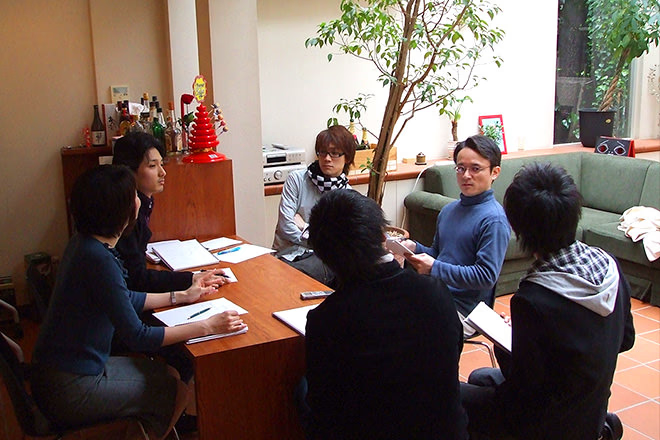
Meeting scene for the first Dream Curtain Project.
At the first meeting, our leader, Sakamoto, started by saying the following.
"The curtains we make are not just for shade. The success of meetings and business negotiations held here will depend on the curtains we make. So these are not just curtains, they are curtains that open up the future."
It was about the significance of the "Dream Curtain Project." The members, having received Sakamoto's passionate thoughts, got to work.
First, we drew up a schedule and discussed the design. How would we attach curtains to a skylight that was about 12 tatami mats in size? We brainstormed ideas such as using a vertical wooden frame and horizontal poles to hang a long piece of cloth on each row, and then attaching tablecloth weights to the ends to stabilize them, and then we decided on the details.
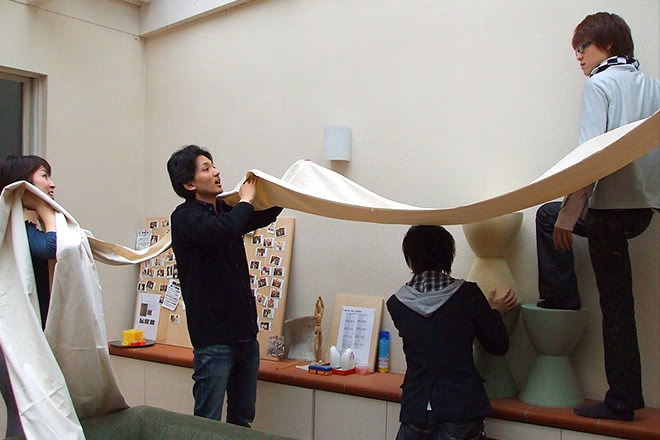
The project members work together to test attaching curtains to poles in the ceiling.
After taking rough measurements, we actually attached the fabric before sewing, checked the details, arranged for anything missing, and then started making the curtains in earnest. The members cut the fabric and worked hard on sewing the enormous length of fabric. Other staff members also helped out during breaks, and we all worked together to complete the curtains little by little.
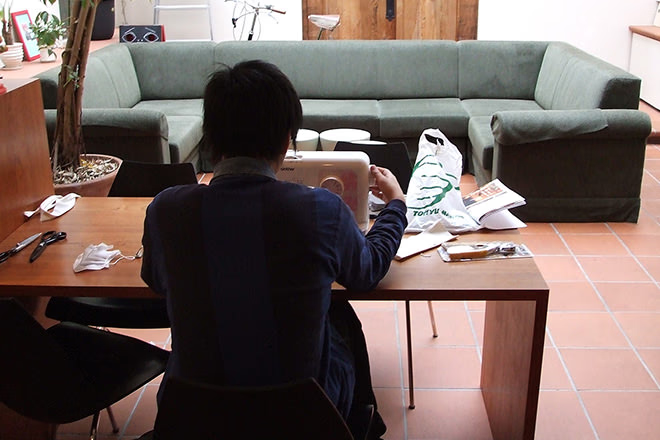
Staff busily sew curtains in between their regular work.
Then, when they attached the completed curtains to the skylight using a stepladder, their very own "dream curtains" appeared. The direct sunlight was filtered through the curtains into a soft light, and they no longer had to run away complaining that their head was too hot.

It may sound a bit exaggerated, but under the fun name "Dream Curtain Project," everyone, led by leader Sakamoto, took on this DIY project. Rather than doing it out of a sense of obligation, the curtains were made with the desire to "have fun and make improvements to the place where we spend our time." Looking back, there may have been some immature moments, but I think this project was the beginning of Monosasu-style DIY, which has continued to evolve ever since.
Places and things that create a comfortable working environment
In the Monosus office, there are several facilities, things, and places that are not directly related to work. A large commercial kitchen, a specialty coffee machine, a ping pong table, a bar counter, etc. At first, they did not have a clear purpose. Rather, they were over-specced for us at the time, and we did not really understand why they were there.
However, these things that may seem "foreign" in the workplace have become a stage for ingenuity, are used in unexpected ways, and are a place that everyone can enjoy.
We will introduce places and things that are not directly related to work, but that contribute to our "comfort at work."
kitchen
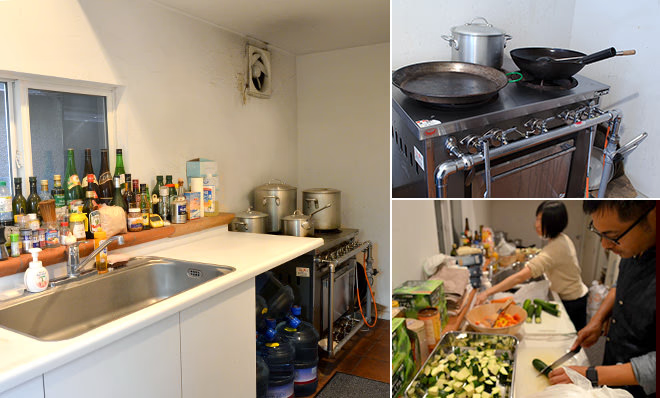
A professional-grade kitchen with a commercial stove, a large sink and worktop, and a large refrigerator. When they moved in, there was talk of demolishing the kitchen because it wasn't necessary in the office, but it was left in place at the insistence of the company's president, Mr. Hayashi.
Having a kitchen allowed everyone to make lunches and dinners between work, and Hayashi began using his cooking skills to prepare meals for the staff. Food for the company's anniversary party, which is held every year and guests are invited to, is also prepared here, and gradually the company acquired a full range of cooking utensils and seasonings. Now, the company has a full range of equipment, including authentic stockpots, woks, paella pans, and frying pans. Perhaps because of this, the scale of the anniversary party has grown every year, and now food for about 200 people is prepared here.
It may be thanks to this kitchen that Monosus' culture of "everyone dining together" was born.
The plates and large rice cooker used in the company cafeteria two days a week are also kept here.
Darts machine and ping pong table
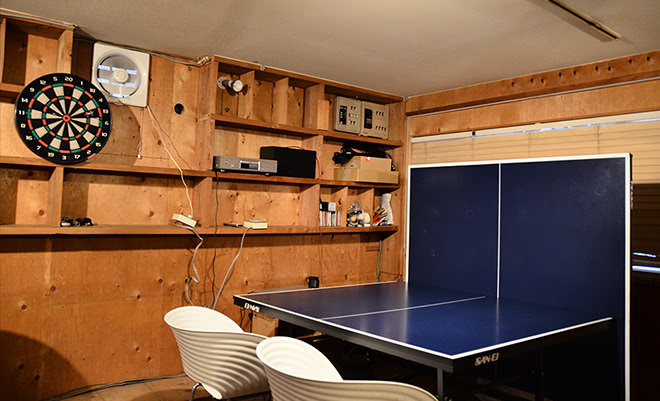
The break area, called "Monosus Cafe," is equipped with a darts machine and a ping-pong table. Staff members who come to drink coffee can often be seen playing darts as a way to unwind.
The ping pong table was introduced for the vague reason that "it would be fun to have a ping pong table in the company." It was originally placed in the large conference room and used as a conference table and as a ping pong table when there were no meetings, but now it is used almost exclusively as a table in the break room. It occasionally comes into its own as a ping pong table, such as during the company's anniversary party.
Bar counter
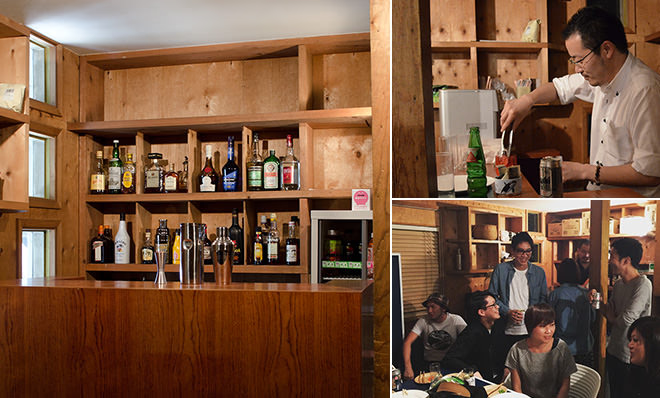
The bar counter, lined with spirits and liqueurs, was newly built when we moved, at the suggestion of former bartender Tatsuta (head of the marketing department).
At first, it was unclear what the space would be used for or how often it would be used, but it has since become an indispensable place for everyone to gather; volunteers would gather there for a drink after work, the bar became the setting for Bar Monosus, which opens irregularly, and it is also used for anniversary parties.
In pursuit of "work comfort"...
An unfinished office that continues to change
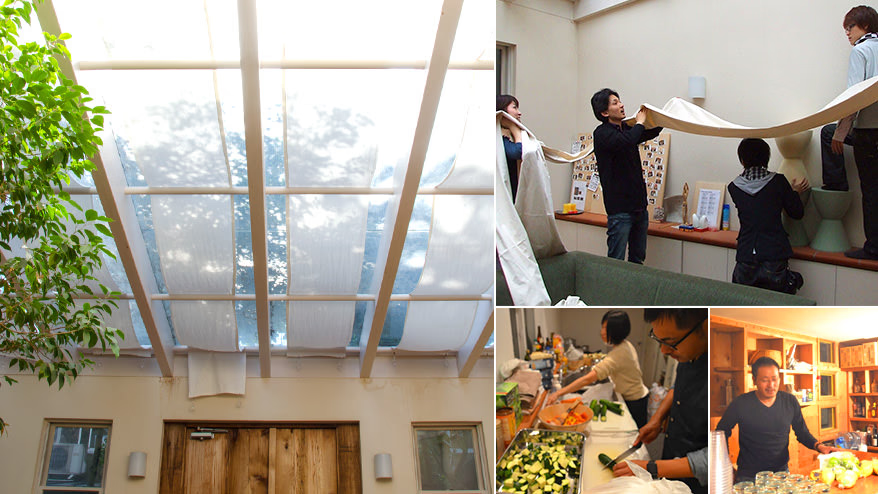
In the previous article, "Until I Met the Office ," we talked about "offices that feel like home," and "comfort at work" may be related to "comfort to live in." Since the office is a place shared by everyone, it is not a perfect "home," but it is necessary to be creative in order to make it comfortable for everyone to spend time and work.
This space was previously an atelier and residence for an architectural designer, so there was no need to make major changes to the interior, but there were some hurdles to overcome before a web production company could move in. We made small changes to the space as an extension of our everyday lives, such as demolishing the walls that divided the space into small sections, installing sliding doors in the meeting space, and making curtains as introduced in this article. We are currently working on creating a community space in the courtyard.
Why did they decide to leave the office unfinished with so many gaps in the first place? We asked CEO Hayashi.
"I think it was unconscious, but I have a urge to place things that are hard to understand. I like to prepare things that seem out of place, like over-spec equipment with no set use, or places where no one knows who will use it or how. When I see someone start using it on their own, or in an unexpected way, I feel happy. Maybe people are drawn to things that have no set owner. I enjoy everyone's movements like that."
When people have equipment that is beyond their means, spare rooms, or spaces that don't belong to anyone, they wonder if they can do something with them. Being attracted to such surplus or unfamiliar items, finding your own way to use them, and enjoying customizing them to make them easier to use can be called "mono-ru-style DIY."
By enjoying this kind of DIY and making small tweaks to the space we work in, we feel we can create our own "comfortable place to work." We will continue to work on our "unfinished office" as we seek out what makes a "comfortable place to work" at any given time.
